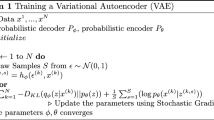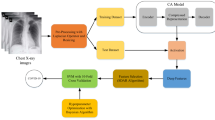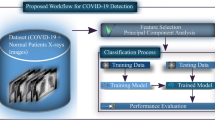Abstract
The novel coronavirus 2019 (COVID-19) has rapidly spread, evolving into a global epidemic. Existing pharmaceutical techniques and diagnostic tests, such as reverse transcription–polymerase chain reaction (RT-PCR) and serology tests, are time-consuming, expensive, and require well-equipped laboratories for analysis. This restricts their accessibility to a broader population. The need for a simple and accurate screening method is imperative to identify infected individuals and curtail the virus’s propagation. In this paper, we introduce a novel COVID-19 classification and detection approach (LSAE, latent space autoencoder) based on chest X-ray image scans. Initially, the high dimensionality of input data is compressed into a reduced representation (latent space), preserving crucial features while discarding noise. This latent space subsequently serves as the input to build an efficient SVM classifier for COVID-19 detection. Experimental outcomes using the COVID-19 dataset are promising as they confirm the rapidity and detection capability of the proposed LSAE.















Similar content being viewed by others
Data Availability
The datasets used during the current study are freely available in the UCI repository.
Code Availability
The code will be available upon request to reviewers.
References
Cascella M, Rajnik M, Aleem A, Dulebohn SC, Di Napoli R (2022) Features, evaluation, and treatment of coronavirus (COVID-19). Statpearls [Internet]
Pokhrel P, Hu C, Mao H (2020) Detecting the coronavirus (COVID-19). ACS Sens 5(8):2283–2296
Sohrabi C, Mathew G, Franchi T, Kerwan A, Griffin M, Del Mundo JSC, Ali SA, Agha M, Agha R (2021) Impact of the coronavirus (COVID-19) pandemic on scientific research and implications for clinical academic training - a review. Int J Surg 86:57–63. https://doi.org/10.1016/j.ijsu.2020.12.008
Worobey M (2021) Dissecting the early COVID-19 cases in Wuhan. Science 374(6572):1202–1204. https://doi.org/10.1126/science.abm4454
Jiang DH, Roy DJ, Gu BJ, Hassett LC, McCoy RG (2021) Postacute sequelae of severe acute respiratory syndrome coronavirus 2 infection: a state-of-the-art review. Basic Transl Sci 6(9–10):796–811. https://doi.org/10.1016/j.jacbts.2021.07.002
Teymouri M, Mollazadeh S, Mortazavi H, Ghale-Noie ZN, Keyvani V, Aghababaei F, Hamblin MR, Abbaszadeh-Goudarzi G, Pourghadamyari H, Hashemian SMR et al (2021) Recent advances and challenges of RT-PCR tests for the diagnosis of COVID-19. Pathol Res Pract 221:153443. https://doi.org/10.1016/j.prp.2021.153443
Giri B, Pandey S, Shrestha R, Pokharel K, Ligler FS, Neupane BB (2021) Review of analytical performance of COVID-19 detection methods. Anal Bioanal Chem 413(1):35–48
Aishwarya T, Ravi Kumar V (2021) Machine learning and deep learning approaches to analyze and detect COVID-19: a review. SN Comput Sci 2(3):226. https://doi.org/10.1007/s42979-021-00605-9
Wang S, Kang B, Ma J, Zeng X, Xiao M, Guo J, Cai M, Yang J, Li Y, Meng X et al (2021) A deep learning algorithm using CT images to screen for corona virus disease (COVID-19). Eur Radiol 31:6096–6104
Eskandarian R, Alizadehsani R, Behjati M, Zahmatkesh M, Sani ZA, Haddadi A, Kakhi K,Roshanzamir M, Shoeibi A, Hussain S et al (2023) Identification of clinical features associated with mortality in COVID-19 patients. In: Operations Research Forum, vol. 4. Springer. p 16. https://doi.org/10.1007/s43069-022-00191-3
Alshazly H, Linse C, Abdalla M, Barth E, Martinetz T (2021) COVID-nets: deep CNN architectures for detecting COVID-19 using chest CT scans. Peer J Comput Sci 7:655
Fang Y, Zhang H, Xie J, Lin M, Ying L, Pang P, Ji W (2020) Sensitivity of chest CT for COVID-19: comparison to RT-PCR. Radiology 296(2):115–117
Dede G, Filiopoulou E, Paroni D-V, Michalakelis C, Kamalakis T (2023) Analysis and evaluation of major COVID-19 features: a pairwise comparison approach. In: Operations Research Forum, vol. 4. Springer. p 15. https://doi.org/10.1007/s43069-023-00201-y
Miron R, Moisii C, Dinu S, Breaban M (2021) COVID detection in chest CTS: improving the baseline on COV19-CT-DB. Preprint at http://arxiv.org/abs/2107.04808, https://doi.org/10.48550/arXiv.2107.04808
Thakur S, Kumar A (2021) X-ray and CT-scan-based automated detection and classification of COVID-19 using convolutional neural networks (CNN). Biomed Signal Process Control 69:102920. https://doi.org/10.1016/j.bspc.2021.102920
Ahmed W, Simpson SL, Bertsch PM, Bibby K, Bivins A, Blackall LL, Bofill-Mas S, Bosch A, Brandão J, Choi PM et al (2022) Minimizing errors in RT-PCR detection and quantification of SARS-Cov-2 RNA for wastewater surveillance. Sci Total Environ 805:149877. https://doi.org/10.1016/j.scitotenv.2021.149877
Hemdan EE-D, Shouman MA, Karar ME (2020) COVIDX-Net: a framework of deep learning classifiers to diagnose COVID-19 in X-ray images. Preprint at http://arxiv.org/abs/2003.11055, https://doi.org/10.48550/arXiv.2003.11055
Salehi S, Abedi A, Balakrishnan S, Gholamrezanezhad A et al (2020) Coronavirus disease 2019 (COVID-19): a systematic review of imaging findings in 919 patients. Ajr Am J Roentgenol 215(1):87–93. https://doi.org/10.2214/ajr.20.23034
Parekh M, Donuru A, Balasubramanya R, Kapur S (2020) Review of the chest CT differential diagnosis of ground-glass opacities in the COVID era. Radiology 297(3):289–302. https://doi.org/10.1148/radiol.2020202504
Shamrat FJM, Azam S, Karim A, Ahmed K, Bui FM, De Boer F (2023) High-precision multiclass classification of lung disease through customized MobileNetV2 from chest X-ray images. Comput Biol Med 155:106646. https://doi.org/10.1016/j.compbiomed.2023.106646
Shamrat FJM, Azam S, Karim A, Islam R, Tasnim Z, Ghosh P, De Boer F (2022) LungNet22: a fine-tuned model for multiclass classification and prediction of lung disease using X-ray images. J Personal Med 12(5):680. https://doi.org/10.3390/jpm12050680
Shamrat F, Chakraborty S, Ahammad R, Shitab TM, Kazi MA, Hossain A, Mahmud I (2022) Analysing most efficient deep learning model to detect COVID-19 from computer tomography images. Indones J Electr Eng Comput Sci 26(1):462–471. https://doi.org/10.11591/ijeecs.v26.i1.pp462-471
Peek N, Combi C, Marin R, Bellazzi R (2015) Thirty years of artificial intelligence in medicine (AIME) conferences: a review of research themes. Artif Intell Med 65(1):61–73. https://doi.org/10.1016/j.artmed.2015.07.003
Becker A (2019) Artificial intelligence in medicine: what is it doing for us today? Health Pol Technol 8(2):198–205. https://doi.org/10.1016/j.hlpt.2019.03.004
Noorbakhsh-Sabet N, Zand R, Zhang Y, Abedi V (2019) Artificial intelligence transforms the future of health care. Am J Med 132(7):795–801
Akter S, Shamrat FJM, Chakraborty S, Karim A, Azam S (2021) COVID-19 detection using deep learning algorithm on chest X-ray images. Biology 10(11):1174. https://doi.org/10.3390/biology10111174
Pisner DA, Schnyer DM (2020) Support vector machine. In: Machine Learning. Elsevier. pp 101–121
Shamrat FJM, Akter S, Azam S, Karim A, Ghosh P, Tasnim Z, Hasib KM, De Boer F, Ahmed K (2023) AlzheimerNet: an effective deep learning based proposition for Alzheimer’s disease stages classification from functional brain changes in magnetic resonance images. IEEE Access 11:16376–16395. https://doi.org/10.1109/ACCESS.2023.3244952
Akhiat Y, Asnaoui Y, Chahhou M, Zinedine A (2021) A new graph feature selection approach. In: 2020 6th IEEE Congress on Information Science and Technology (CiSt). IEEE. pp 156–161
Akhiat Y, Manzali Y, Chahhou M, Zinedine A (2021) A new noisy random forest-based method for feature selection. Cybern Inf Technol 21(2):10–28
Akhiat Y, Chahhou M, Zinedine A (2019) Ensemble feature selection algorithm. Int J Intell Syst Appl 11(1):24
Akhiat Y, Chahhou M, Zinedine A (2018) Feature selection based on graph representation. In: 2018 IEEE 5th International Congress on Information Science and Technology (CiSt). IEEE. pp 232–237
Bouchlaghem Y, Akhiat Y, Amjad S (2022) Feature selection: a review and comparative study. In: E3S Web of Conferences, vol. 351. EDP Sciences. p 01046
Manzali Y, Akhiat Y, Chahhou M, Elmohajir M, Zinedine A (2022) Reducing the number of trees in a forest using noisy features. Evol Syst 1–18
Akhiat Y, Touchanti K, Zinedine A, Chahhou M (2023) IDS-EFS: ensemble feature selection-based method for intrusion detection system. Multimed Tools Appl 1–21. https://doi.org/10.1007/s11042-023-15977-8
Ansari G, Ahmad T, Doja MN (2019) Hybrid filter-wrapper feature selection method for sentiment classification. Arab J Sci Eng 44:9191–9208. https://doi.org/10.1007/s13369-019-04064-6
Dabas N, Ahlawat P, Sharma P (2022) An effective malware detection method using hybrid feature selection and machine learning algorithms. Arab J Sci Eng 1–19. https://doi.org/10.1007/s13369-022-07309-z
Hasija S, Akash P, Hemanth MB, Kumar A, Sharma S (2022) A novel approach for detection of COVID-19 and pneumonia using only binary classification from chest CT-scans. Neurosci Inform 2(4):100069. https://doi.org/10.1016/j.neuri.2022.100069
Al-Khafagy AM, Hashim SR, Enad RA (2022) A unique deep-learning-based model with chest X-ray image for diagnosing COVID-19. Indones J Electr Eng Comput Sci 28(2):1147–1154. https://doi.org/10.11591/ijeecs.v28.i2.pp1147-1154
Panwar H, Gupta P, Siddiqui MK, Morales-Menendez R, Singh V (2020) Application of deep learning for fast detection of COVID-19 in X-rays using nCOVnet. Chaos Solit Fract 138:109944. https://doi.org/10.1016/j.chaos.2020.109944
Naeem H, Bin-Salem AA (2021) A CNN-LSTM network with multi-level feature extraction-based approach for automated detection of coronavirus from CT scan and X-ray images. Appl Soft Comput 113:107918. https://doi.org/10.1016/j.asoc.2021.107918
Hemdan EE-D, Shouman MA, Karar ME (2020) COVIDX-Net: a framework of deep learning classifiers to diagnose COVID-19 in X-ray images. Preprint at http://arxiv.org/abs/2003.11055. https://doi.org/10.48550/arXiv.2003.11055
Das NN, Kumar N, Kaur M, Kumar V, Singh D (2022) Automated deep transfer learning-based approach for detection of COVID-19 infection in chest X-rays. IRBM 43(2):114–119. https://doi.org/10.1016/j.irbm.2020.07.001
Xie X, Zhong Z, Zhao W, Zheng C, Wang F, Liu J (2020) Chest CT for typical coronavirus disease 2019 (COVID-19) pneumonia: relationship to negative RT-PCR testing. Radiology 296(2):41–45. https://doi.org/10.1148/radiol.2020200343
Huang P, Liu T, Huang L, Liu H, Lei M, Xu W, Hu X, Chen J, Liu B (2020) Use of chest CT in combination with negative RT-PCR assay for the 2019 novel coronavirus but high clinical suspicion. Radiology 295(1):22–23. https://doi.org/10.1148/radiol.2020200330
Cervantes J, Garcia-Lamont F, Rodríguez-Mazahua L, Lopez A (2020) A comprehensive survey on support vector machine classification: applications, challenges and trends. Neurocomputing 408:189–215
Sheykhmousa M, Mahdianpari M, Ghanbari H, Mohammadimanesh F, Ghamisi P, Homayouni S (2020) Support vector machine versus random forest for remote sensing image classification: a meta-analysis and systematic review. IEEE J Select Topics Appl Earth Observ Remote Sens 13:6308–6325
Gu J, Wang Z, Kuen J, Ma L, Shahroudy A, Shuai B, Liu T, Wang X, Wang G, Cai J et al (2018) Recent advances in convolutional neural networks. Patt Recognit 77:354–377. https://doi.org/10.1016/j.patcog.2017.10.013
Simonyan K, Zisserman A (2014) Very deep convolutional networks for large-scale image recognition. Preprint at http://arxiv.org/abs/1409.1556. https://doi.org/10.48550/arXiv.1409.1556
Rodríguez-Fdez I, Canosa A, Mucientes M, Bugarín A (2015) STAC: a web platform for the comparison of algorithms using statistical tests. In: Proceedings of the 2015 IEEE International Conference on Fuzzy Systems (FUZZ-IEEE)
Author information
Authors and Affiliations
Contributions
YB and YA wrote the main manuscript. KT proposed the methodology and prepared the figures. All authors reviewed the manuscript.
Corresponding author
Ethics declarations
Ethical Approval
Not applicable
Consent to Participate
Not applicable
Consent for Publication
All authors of the manuscript have agreed to authorship, read and approved the manuscript, and given consent for the submission of the manuscript.
Competing Interests
The authors declare no competing interests.
Additional information
Publisher's Note
Springer Nature remains neutral with regard to jurisdictional claims in published maps and institutional affiliations.
Rights and permissions
Springer Nature or its licensor (e.g. a society or other partner) holds exclusive rights to this article under a publishing agreement with the author(s) or other rightsholder(s); author self-archiving of the accepted manuscript version of this article is solely governed by the terms of such publishing agreement and applicable law.
About this article
Cite this article
Bouchlaghem, Y., Akhiat, Y., Touchanti, K. et al. LSAE: Autoencoder Latent Space for Dimensionality Reduction-Based Approach for COVID-19 Classification and Detection Task Using Chest X-ray. Oper. Res. Forum 4, 95 (2023). https://doi.org/10.1007/s43069-023-00278-5
Received:
Accepted:
Published:
DOI: https://doi.org/10.1007/s43069-023-00278-5




